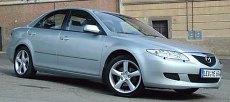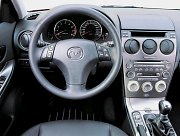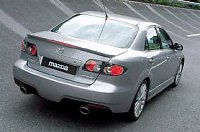 Mazda
6 represents quite a few significant changes at Mazda: firstly, naming
system has been changed from 323 / 626 / 929 etc. to a single number.
That
means the mid-size 626 is now called simply Mazda 6, while the
forthcoming
replacement for 323 will be called Mazda 3. Secondly, the new car
signals
the end of the cost-reduction era shadowing the company since the
mid-90s.
Bye-bye the cheap and boring 626, enters the more sophisticated Mazda
6.
The new car is also designed to be far more driver-focused, offering
handling
and driving fun superior to your average Accord or Camry, signaling the
third change to the company strategy - Mazda wants to convert its own
image
to a driver-oriented brand like somewhere between Honda and BMW. Such a
180-degree change might be hard to accept, but note that parent company
Ford (well, I mean European Ford) has nearly achieved that. On the
other
hand, Mazda has a couple of strong products to back up that change -
the
classic MX-5 and the forthcoming Wankel-engined RX-8. It seems that
under
the global strategy of Ford empire, Mazda will be made even sportier
than
European Ford. Mazda
6 represents quite a few significant changes at Mazda: firstly, naming
system has been changed from 323 / 626 / 929 etc. to a single number.
That
means the mid-size 626 is now called simply Mazda 6, while the
forthcoming
replacement for 323 will be called Mazda 3. Secondly, the new car
signals
the end of the cost-reduction era shadowing the company since the
mid-90s.
Bye-bye the cheap and boring 626, enters the more sophisticated Mazda
6.
The new car is also designed to be far more driver-focused, offering
handling
and driving fun superior to your average Accord or Camry, signaling the
third change to the company strategy - Mazda wants to convert its own
image
to a driver-oriented brand like somewhere between Honda and BMW. Such a
180-degree change might be hard to accept, but note that parent company
Ford (well, I mean European Ford) has nearly achieved that. On the
other
hand, Mazda has a couple of strong products to back up that change -
the
classic MX-5 and the forthcoming Wankel-engined RX-8. It seems that
under
the global strategy of Ford empire, Mazda will be made even sportier
than
European Ford.
I saw the Mazda 6 recently in a motor show and was impressed by its "traditional" styling. I said "traditional" is because it follows the tradition of Japanese sedans to offer a light, sleek looking shape with relatively low shoulder lines compare with European sedans. The curves flowing smoothly from nose to tail make the 6 look small and dynamic. Details, however, are either not mature or not elegant enough. For example, the flashy Lexus-IS-like taillights are more fashionable than long-lasting. Is it just a coincidence? the Japanese name of Mazda 6, Atenza, is also surprisingly close to the Japanese name of the baby Lexus, Toyota Altezza. However, in heart and bores they are very different indeed. The Mazda 6 still follows the conventional mid-size sedan rules by offering front-wheel-drive chassis and transversely-mounted four-cylinder engines. In other words, it competes right in the same segment as Ford Mondeo and Volkswagen Passat. In the USA, where it will be built there as well, Mazda 6 will target at Nissan Altima, Toyota Camry and Honda Accord - all are slightly larger. It is a world car.
Nevertheless, this is a driver’s car that excels in moving rather than standstill. Throw it into a couple of bends and it immediately shows how impressive it handles. Communicative and direct steering, stiff chassis, excellent body control, fine damping and accessible throttle steer let it matches Mondeo in handling - the first time so far in this segment! like the Mondeo, it has a little bit trade-off in ride quality, which is firm rather than supple, but what trouble the Mazda is actually excessive suspension noise over rough B-roads. In addition to the annoying engine noise (will be discussed soon), the Mazda 6 is less refined and comfortable than the Mondeo. A good driver’s car is not in doubt, just not matching the completeness of Mondeo. What contribute to the great handling are some new suspensions. The front rides on double-wishbones with a long strut-type damper/spring unit. The latter made some journalists confused it with conventional MacPherson strut. At the back, there is a new multi-link setup which is so compact that does not intrude into luggage compartment at all. No wonder the boot provides 500 litres of flat cargo loading.
Next up is the most popular in USA market - a longer stroke version of the aforementioned MZR four-cylinder family displacing 2.3 litres. Apart from extra cc, it gets S-VT (sequential - or continusously - variable valve timing) and variable intake manifold to enable 165 horsepower and a flat torque curve which delivers at least 90% of maximum torque from 1750 to 6000rpm! the larger 4-pot engine is also benefited from twin-balancer shafts to guarantee smooth running up to its 7000rpm cut-out. Is it a fireball? not yet, because it has to propel some 1400kg of kerb weight. Expect 0-60mph in 8.4 seconds. For real performance, American market gets a 3.0-litre 24V V6 based on Ford’s Duratec but added with S-VT. The outcome is 219hp and 202lbft. It is a potential rival to Mondeo ST220, but unfortunately: a) it mates with automatic transmission only; b) it gets no sportier chassis setup; c) it is not on sale in Europe while Mondeo is not available to America. To sum up the
Mazda 6, we
can say it is a good car by AutoZine standard - which places driving
fun
in higher priority. However, while it matches Mondeo in driver appeal,
it cannot match its completeness. The Ford is as much fun to attack
corners
while offering more space, higher quality and better refinement.
|
| The above report was last updated on 27 July 2002. All Rights Reserved. |
 As
I sat in the rear seat, I am sure it does not offer as much space as
its
American rivals as well as Ford Mondeo. In fact, the 2675mm wheelbase
is
a decisive 80mm shorter than the Mondeo. It can still sit 6-footer
comfortably
at the back, but cannot match the feel of spaciousness as experienced
in
a Mondeo. At the front, you sit low in the "traditional" way, feeling
sportier
than today’s taller and taller rivals. Front seats are supportive and
comfortable.
The fake-alloy plastic panel over center console with 3 beautiful
ventilation
holes and a pop-up DVD satellite navigation screen inject an extra
sense
of sportiness. Even more so is the beautiful speedometer and revcounter
with chromed rims. In terms of materials and trimming, they are up to
modern
standard but never feel luxurious. That said, plastics quality is
inferior
to Mondeo’s.
As
I sat in the rear seat, I am sure it does not offer as much space as
its
American rivals as well as Ford Mondeo. In fact, the 2675mm wheelbase
is
a decisive 80mm shorter than the Mondeo. It can still sit 6-footer
comfortably
at the back, but cannot match the feel of spaciousness as experienced
in
a Mondeo. At the front, you sit low in the "traditional" way, feeling
sportier
than today’s taller and taller rivals. Front seats are supportive and
comfortable.
The fake-alloy plastic panel over center console with 3 beautiful
ventilation
holes and a pop-up DVD satellite navigation screen inject an extra
sense
of sportiness. Even more so is the beautiful speedometer and revcounter
with chromed rims. In terms of materials and trimming, they are up to
modern
standard but never feel luxurious. That said, plastics quality is
inferior
to Mondeo’s.  Before
the car launched, there were talks about sharing platform with Ford
Mondeo.
That did not come true - at least for the current generation Mondeo -
because
both platforms are entirely different. In fact, the only major common
part
is engine. If you remember, I already pointed out in my Mondeo report
that
the four-cylinder engine family was primarily designed by Mazda and
then
adapted to Ford. Take the largest-selling 2.0-litre 16V engine as an
example.
No matter in the Mazda or the Mondeo they displace 1999c.c., having the
same all-alloy construction, the same compression ratio, the same bore
and stroke dimensions... the only difference is that the Mazda lacks
variable
intake manifolds thus produces only 142hp and 134lbft, down 3hp and
6lbft
from the Mondeo. The Mazda engine with fixed intake manifold also
suffers
from excessive noise at high-speed cruising. Seems that Mazda sometimes
emphasis driver appeal in the wrong places.
Before
the car launched, there were talks about sharing platform with Ford
Mondeo.
That did not come true - at least for the current generation Mondeo -
because
both platforms are entirely different. In fact, the only major common
part
is engine. If you remember, I already pointed out in my Mondeo report
that
the four-cylinder engine family was primarily designed by Mazda and
then
adapted to Ford. Take the largest-selling 2.0-litre 16V engine as an
example.
No matter in the Mazda or the Mondeo they displace 1999c.c., having the
same all-alloy construction, the same compression ratio, the same bore
and stroke dimensions... the only difference is that the Mazda lacks
variable
intake manifolds thus produces only 142hp and 134lbft, down 3hp and
6lbft
from the Mondeo. The Mazda engine with fixed intake manifold also
suffers
from excessive noise at high-speed cruising. Seems that Mazda sometimes
emphasis driver appeal in the wrong places.  Since
the death of Mitsubishi Galant VR4, Japanese sports saloon market
seemed
calm down. Now Mazda 6 MPS (or called Mazdaspeed 6 in the United
States)
is going to revive this market.
Since
the death of Mitsubishi Galant VR4, Japanese sports saloon market
seemed
calm down. Now Mazda 6 MPS (or called Mazdaspeed 6 in the United
States)
is going to revive this market.
 The
chassis also received a lot of attention. Chassis rigidity is raised by
an astonishing 50%, thanks to an additional tower bar over the rear
suspensions,
an additional cross brace hiding behind the dashboard,
strengthened
suspensions mountings and A-pillar anchor points. Suspensions remains
the
same strut and multi-link setup, but the tweaked setup enhance body
control.
Front and rear springs are stiffened by 25% and 37% respectively,
together
with thicker anti-roll bars. All four corners now employ 18-inch alloy
wheels wrapping with 215/45 tires.
The
chassis also received a lot of attention. Chassis rigidity is raised by
an astonishing 50%, thanks to an additional tower bar over the rear
suspensions,
an additional cross brace hiding behind the dashboard,
strengthened
suspensions mountings and A-pillar anchor points. Suspensions remains
the
same strut and multi-link setup, but the tweaked setup enhance body
control.
Front and rear springs are stiffened by 25% and 37% respectively,
together
with thicker anti-roll bars. All four corners now employ 18-inch alloy
wheels wrapping with 215/45 tires.